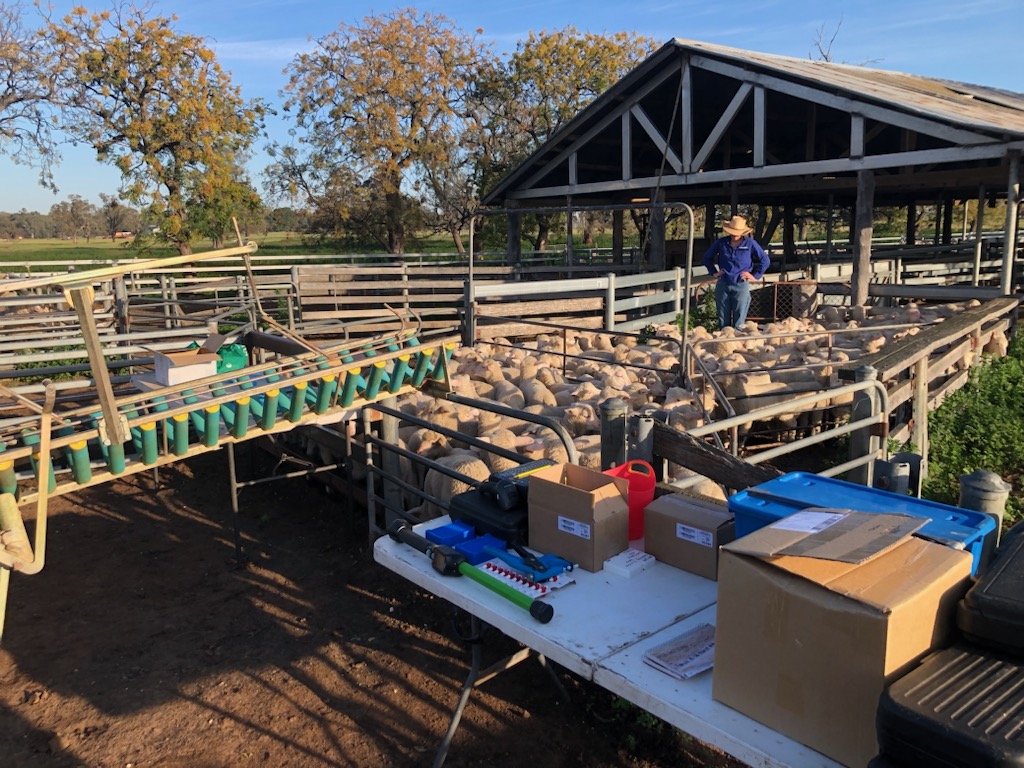Sire evaluation open day set to deliver Dohne trial results
Article courtesy of ACM (Bec Adam) The Land Stock & Land Stock Journal Farm Weekly Queensland Country Life

Ben Swain, executive officer of the Australian Merino Sire Evaluation trials, takes the crowd through the various pens of 2021-drop ewes.
Ewe reproductive data from the Dohne Sire Evaluation Trial, along with the results of the meat-eating-quality tests will be released at an open day next month.
The AMSEA Coonong Sire Evaluation Open Day will be held at Coonong Station, Urana, New South Wales, on Wednesday, February 21.
As well as reproduction and meat eating quality additional comprehensive wool and growth performance will be released.
Australian Merino Sire Evaluation Association chief executive officer Ben Swain said the Coonong Station Dohne trial was unique in the extensive range of information being collected, and that breeders would be surprised by the results.
“People are always surprised by the results, especially entrants,” Mr Swain said.
“This is why people put their animals in sire evaluations, because it’s hard to know where you fit in your industry when you are only looking at the sheep on your own farm.
“While you think you might have great reproduction, great meat eating quality, or great wool production, when you put it in a trial and compare it to other genetics, there are often surprises, some good and some bad.”
In collaboration with the Australian Merino Sire Evaluation Association, Dohne stud breeders established the innovative sire evaluation trial at Coonong Station.

Lamb marking Sire valuation ewe progeny August 23, 2023, including DNA TSU sampling, breech and body wrinkle scoring, pigmentation recording and EID taggiing.
There are nine Merino sire evaluation trials being carried out across Australia, with more than 130 sires participating in the program, and the Coonong trial is the only site using Dohne commercial ewes as the breeding base.
“We started with 12 rams and joined them to Dohne ewes to generate the lambs of the sires, and then it’s these ewe lambs which were taken through to the start of the reproduction part of the trial,” he said.
“So those ewe lambs were joined last year, they lambed last year and that’s the reproduction data.”
Mr Swain said the results would be available in various formats, such as how many lambs were born and raised in each the sire group’s ewe, and breeding values, which allowed people to compare the rams against each other based purely on their genetic potential.
But Mr Swain said while these reproduction results would be an indicator of the reproductive performance of those sire’s genetics, it wasn’t the be all and end all.
“We have to remember that it’s only the first year of the reproduction data, so the ewes are now being joined again as we speak and there will be a whole second year of reproduction data, which makes it a lot more robust,” he said.
“We know from two-year-old ewes that the first time they are joined, they can have a very different reproduction performance to when we join them in the second and subsequent years.
“We can look at the results from the first year reproduction data and see, well this ram’s daughters reared the most lambs, but in the second year it might be the worst, so we have to do at least two years.
“At the soon to be concluded Merino Lifetime Productivity trial, also run by AMSEA in conjunction with AWI, we joined the ewes up to five years to get a very accurate estimation of the genetic potential of that ram.”

Falls Transport delivering the Sire Evaluation Wether Lambs to Gundagai Meat Processors from the Coonong Station, Urana.
Mr Swain said the results of the meat-eating-quality tests would also be released at the open day.
“Meat eating quality tests are done across all meats to make them more tastier and appealing to the consumer,” he said
“This testing was done by the University of New England and we are hoping one of the staff will come down and present the results, which will be really interesting.
Mr Swain said rams were bred for different purposes, so depending on the breeders who owned them and their breeding objective, they were trying to breed sheep which were doing different things to others in the trial.
“So while there might be one that has the highest reproduction results, they may have the lowest wool production results, so the reproduction results are interesting because the number of lambs is a big profit driver in the industry, but all the other qualities are equally important too,” he said.
“You rarely get a ram across the hundreds that we test every year that is good at everything, they breed them for their environment and what their business is trying to do.”

Ewe Hoggets classing at Coonong Station, Urana.
The AMSEA Coonong Sire Evaluation Open Day will have the ewes currently in the evaluation on display, and details of the second year of reproduction phase of the evaluation will be discussed, as well updated fleece weight and micron measurements.
The following day on Thursday, February 22 there will be a debriefing held with all members welcome to also attend.
The ADBA will be providing morning tea and lunch on the day and exhibitor stands will be on display throughout the day.
For more information, click HERE.










 Facebook
Facebook YouTube
YouTube Instagram
Instagram